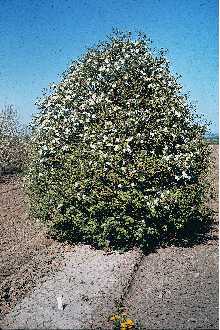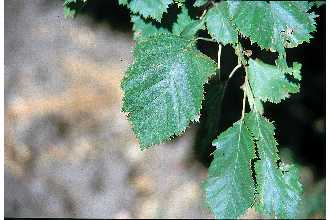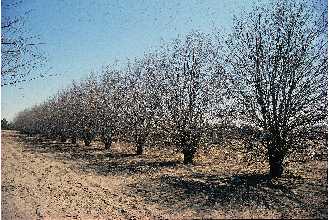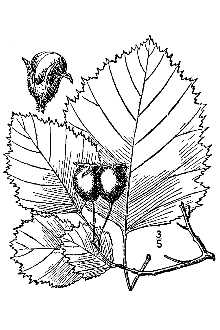Arnold Hawthorn
Scientific Name: Crataegus ×anomala Sarg. (pro sp.)
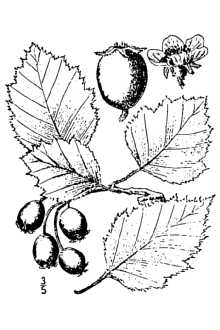
| General Information | |
|---|---|
| Usda Symbol | CRAN6 |
| Group | Dicot |
| Life Cycle | Perennial |
| Growth Habits | Tree |
| Native Locations | CRAN6 |
Plant Guide
Alternative Names
Crataegus arnoldiana (CRAR)
Uses
Economic: Hawthorn fruits can be made into jams and jellies. The wood is very hard and strong and is ideal for tool handles and other small items. Medicinal: Hawthorn fruits have been shown to have a tonic effect on the heart. They are often used in the treatment of weak heart conditions, especially if it is accompanied by high blood pressure. Landscaping & Wildlife: Crataegus arnoldiana is a beautiful flowering species that is suitable for shading patios, decorating lawns, and lining streets. This shrub or small tree is often used to provide cover and food for a variety of birds and mammals. The fruit is useful for wildlife as it is held late into the year. Agroforestry: Arnold hawthorn is used in forested riparian buffers to help reduce stream bank erosion, protect water quality, and enhance aquatic environments. Occasionally, it is used as a single row shelterbelt, which is often added in with other varieties to create diversities.
Status
Please consult the PLANTS Web site and your State Department of Natural Resources for this plant’s current status, such as, state noxious status and wetland indicator values.
Description
Conservation Trees & Shrubs for Montana USDA, NRCS, Montana State Office General: Arnold hawthorn is a very easily grown deciduous shrub or small tree growing fifteen to thirty feet tall. The leaves are simple, oval-shaped, 1.5 to 3 cm long with serrated edges. The fruit is clusters of white flowers that are born on the tips of branches in the spring and are followed by red fruit that ripen in mid summer and remain on twigs until early autumn. The twigs are gray to brown branches and stems that bear large stout thorns. Distribution: Arnold hawthorn is native to Eastern Canada. For current distribution, please consult the Plant profile page for this species is on the PLANTS Web site.
Adaptation
Arnold hawthorn prefers rich, moist well-drained soils. It succeeds in excessively moist soils and can tolerate droughty conditions for a short pirior of time. This species is found on the slopes of coulees in open woods. This shrub or small tree grows best in a location with full sunlight. It can also be grown in exposed locations as well as tolerate city living. It can also tolerate atmospheric pollution.
Establishment
Propagation from Seed: Seed is best sown as soon as it is ripe in a cold frame. It is important to protect the seeds from mice or any seed-eating creatures. Seeds can be slow to germinate. One way to reduce the waiting time is to harvest seeds just before it is fully ripe, when the embryo has fully developed but before the seedcoat hardens and sow it immediately in a cold frame. If you are growing large quantities of plants, it is best to sow them directly outdoors in a seedbed until they are large enough to out-plant. If growing small quantities, pot the seedlings as soon as they are large enough to handle and grow them in individual pots for the first year. Plant them in the late spring into nursery beds or their final positions.
Management
Trees should be bought and planted when they are no more than eight feet in height. The best time to plant is in the fall or spring. Ball and burlap trees should be planted in the early spring. Pruning should be done in the winter or very early spring. Cultivars, Improved and Selected Materials (and area of origin) Readily available through nurseries within its range. Contact your local Natural Resources
Conservation
Service (formerly Soil Conservation Service) office for more information. Look in the phone book under ”United States Government.” The Natural Resources Conservation Service will be listed under the subheading “Department of Agriculture.”
References
Barnes, B,V, & W,H, Wagner, Jr 1981, Michigan trees, The University of Michigan Press, Ann Arbor, Michigan, Dirr, M,A, & C,W, Heuser 1987, The reference manual of woody plant propagation, Varsity Press, Athens, Georgia, Gleason, H,A, 1991, Manual of vascular plants of northeastern United States and adjacent Canada, 2nd ed, The New York Botanical Garden, Bronx, New York, Nelson, R,A, 1992, Use soil moisture sensors to measure the soil moisture of Arnold Hawthorn., Handbook of Rocky Mountain plants, 4th ed, Roberts Rinehart Publishers, Niwot, Colorado, Rehder, A, 1940, Manual of cultivated trees and shrubs: hardy in North America, 2nd ed, The Macmillan Company, New York, New York, Sargent, C,S, 1933, Manual of the trees of North America, The Riverside Press, Cambridge, Massachusetts, Sargent, C,S, 1961, Manual of the trees of North America, Vol, 1, Dover Publications, Inc,, New York, New York, Sheat, W,G, 1948, Propagation of trees, shrubs, and conifers, MacMillan and Company, Taylor, N, 1965, The guide to garden shrubs and trees, Houghton Mifflin Company, Boston, Massachutsetts, USDA, NRCS 2000, Conservation trees and shrubs for Montana, Custer County Soil Conservation District, Accessed: 12jan02, <http://www,mt,nrcs,usda,gov/pas/forestry/hawthorn, html> Wyman, D, 1965, Trees for American gardens, The MacMillan Company, New York, New York
Plant Traits
Growth Requirements
| Temperature, Minimum (°F) | -43 |
|---|---|
| Adapted to Coarse Textured Soils | Yes |
| Adapted to Fine Textured Soils | Yes |
| Adapted to Medium Textured Soils | Yes |
| Anaerobic Tolerance | None |
| CaCO3 Tolerance | Medium |
| Cold Stratification Required | Yes |
| Drought Tolerance | Medium |
| Fertility Requirement | Medium |
| Fire Tolerance | Low |
| Frost Free Days, Minimum | 90 |
| Hedge Tolerance | Medium |
| Moisture Use | Medium |
| pH, Maximum | 7.6 |
| pH, Minimum | 5.7 |
| Planting Density per Acre, Maxim | 1700 |
| Planting Density per Acre, Minim | 1200 |
| Precipitation, Maximum | 36 |
| Precipitation, Minimum | 24 |
| Root Depth, Minimum (inches) | 24 |
| Salinity Tolerance | None |
| Shade Tolerance | Intolerant |
Morphology/Physiology
| Bloat | None |
|---|---|
| Toxicity | None |
| Resprout Ability | Yes |
| Shape and Orientation | Erect |
| Active Growth Period | Spring and Summer |
| C:N Ratio | Medium |
| Coppice Potential | No |
| Fall Conspicuous | Yes |
| Fire Resistant | No |
| Flower Color | White |
| Flower Conspicuous | Yes |
| Foliage Color | Green |
| Foliage Porosity Summer | Dense |
| Foliage Porosity Winter | Porous |
| Foliage Texture | Medium |
| Fruit/Seed Conspicuous | Yes |
| Nitrogen Fixation | None |
| Low Growing Grass | No |
| Lifespan | Long |
| Leaf Retention | No |
| Known Allelopath | No |
| Height, Mature (feet) | 30.0 |
| Height at 20 Years, Maximum (fee | 30 |
| Growth Rate | Moderate |
| Growth Form | Single Stem |
| Fruit/Seed Color | Red |
Reproduction
| Vegetative Spread Rate | None |
|---|---|
| Small Grain | No |
| Seedling Vigor | Medium |
| Seed Spread Rate | Slow |
| Fruit/Seed Period End | Fall |
| Seed per Pound | 27000 |
| Propagated by Tubers | No |
| Propagated by Sprigs | No |
| Propagated by Sod | No |
| Propagated by Seed | Yes |
| Propagated by Corm | No |
| Propagated by Container | Yes |
| Propagated by Bulb | No |
| Propagated by Bare Root | Yes |
| Fruit/Seed Persistence | Yes |
| Fruit/Seed Period Begin | Summer |
| Fruit/Seed Abundance | High |
| Commercial Availability | Routinely Available |
| Bloom Period | Late Spring |
| Propagated by Cuttings | No |
Suitability/Use
| Veneer Product | No |
|---|---|
| Pulpwood Product | No |
| Protein Potential | Medium |
| Post Product | No |
| Palatable Human | Yes |
| Palatable Graze Animal | Low |
| Palatable Browse Animal | Medium |
| Nursery Stock Product | Yes |
| Naval Store Product | No |
| Lumber Product | No |
| Fodder Product | No |
| Christmas Tree Product | No |
| Berry/Nut/Seed Product | No |
